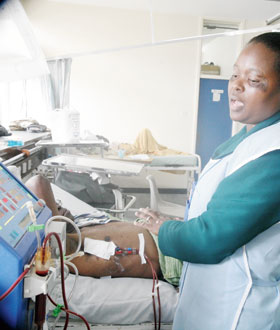By Dann Okoth
As he has done twice-weekly for the last one year, Boniface Ng’ang’a, 46, heads for the Kenyatta National Hospital’s Renal Unit.
A nurse gives him a check-up, before he settles on a bed in a treatment room.
 |
Ms Eileen Sagwe, a senior nurse at the Kenyatta National Hospital Renal Unit, attends to Mr Boniface Ng’ang’a as he undergoes dialysis. [PHOTO: ANNE KAMONI/STANDARD] |
As he faces the ceiling, the nurse attaches two tubes that stick out of his chest — one to ooze out his blood and the other to infuse it back — to a pair of plastic tubes leading to a dialysis machine beside the bed. The tubes are permanently inserted below the skin near his heart to spare him the pain that comes with pricking his arms to access blood vessels every time he goes for dialysis.
The nurse touches a few buttons on the machine before it purrs into action siphoning blood out of Ng’ang’a’s body.
"The blood then goes to the machine’s membrane, which sieves it of impurities before it is pumped back into the body," explains Dr Anthony Were, head of the Renal Unit.
For the next four hours, the patient will lie still as the machine removes waste and extra fluid from the blood.
He passes the hours gazing blankly at the ceiling, perhaps nostalgically re-living his days as a healthy, active person. Occasionally he turns slightly on his side and cranes his neck to see what is going on around him. Too much movement could disturb the tubes jutting out of his body.
In early 2007, Ng’ang’a, a father of four, started experiencing swellings on his body. He visited a doctor who told him he was suffering from chronic renal failure. "You have an advanced kidney illness… You have two options, get a kidney transplant or undergo weekly dialysis," the doctor said.
Ng’ang’a could not afford the money for surgery so he chose dialysis. It is a strenuous, often painful, routine which costs him Sh20,000 per week at the subsidised Kenyatta National Hospital.
Ng’ang’a’s condition was caused by high blood sugar that was only detected when he was diagnosed with a kidney ailment. "I have considered getting a transplant and I’m organising a fundraiser to enable me undergo the operation abroad," he says.
Toll
For now, eight hours of dialysis every week keeps him alive. The procedure has taken a physical, emotional and financial toll on him.
Basically, his kidneys have collapsed and cannot rid his body of waste. After a few days, his body chokes with waste products, which if not discharged could kill him.
Stay informed. Subscribe to our newsletter
During a session, the earthen tube is connected to the right artery, which drains the blood from the body and channels it to the dialysis machine for cleansing and the venous chambers tube that directs dialysed or clean blood back to the body.
"Getting the arteries to supply the correct amount of blood to the machine can be very difficult," explains Ms Eileen Sagwe, a senior nurse at the unit.
Ng’ang’a’s battered body is testimony to that struggle. His right arm bears an ugly cut right across it while the left arm has swollen lymph nodes.
The membrane in the machine, Were explains, consists of two compartments separated by a semi-porous wall. "On one side is the impure blood from the body and on the other is concentrate siphoned from a container beneath the dialyser," says Were.
Equilibrium
The concentrate contains minerals and ions required by the body. "Through the process of osmosis, an exchange occurs between the two liquids until there is an equilibrium, after which the purified blood is pumped back into the body and excess impurities discharged," Were explains.
Impurities in the patient’s body and weight gain determines the amount of time spent on dialysis. "
"The machine monitors and controls the patient’s temperature, blood pressure and other vitals. One nurse can oversee over five patients on dialysis simultaneously," says Sagwe.
Critical
Apart from such rare cases, the process is often smooth with the nurses only required to inject 4ml of Hapamine drug into the machine after every hour to prevent the blood from clotting. "Ideally, the patient should stand up as soon as a session is over and walk," she says.
But Ng’ang’a’s case is complicated. "I can only work for two days a week and the cost of dialysis is too much," he says.
Apart from the Sh4,500 spent on a dialysis session, for which he has to buy the required concentrate, he also spends Sh1,000 on an injection to boost his blood, another Sh1,000 for mineral tablets, Sh700 for blood claritin test —analysis of blood sample, Sh1000 doctor’s fee and Sh2,000 on miscellaneous requirements. "The total cost for two sessions a week comes to about Sh20,000 yet I don’t work anymore and rely heavily on relatives and well wishers," he says.
—Wellwishers can reach Ng’ang’a on Mobile No: 0711458399.
 The Standard Group Plc is a
multi-media organization with investments in media platforms spanning newspaper
print operations, television, radio broadcasting, digital and online services. The
Standard Group is recognized as a leading multi-media house in Kenya with a key
influence in matters of national and international interest.
The Standard Group Plc is a
multi-media organization with investments in media platforms spanning newspaper
print operations, television, radio broadcasting, digital and online services. The
Standard Group is recognized as a leading multi-media house in Kenya with a key
influence in matters of national and international interest.
 The Standard Group Plc is a
multi-media organization with investments in media platforms spanning newspaper
print operations, television, radio broadcasting, digital and online services. The
Standard Group is recognized as a leading multi-media house in Kenya with a key
influence in matters of national and international interest.
The Standard Group Plc is a
multi-media organization with investments in media platforms spanning newspaper
print operations, television, radio broadcasting, digital and online services. The
Standard Group is recognized as a leading multi-media house in Kenya with a key
influence in matters of national and international interest.









